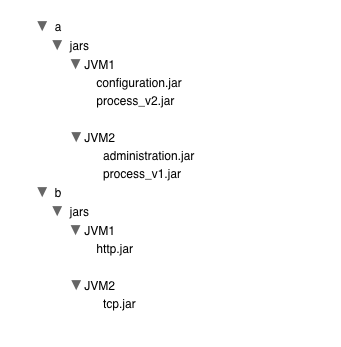Deployment directories provide a mechanism for installing JAR files on a node that are implicitly added to a JVM's class path.
Deployment directories are not added to a JVM's class path, only the JAR files contained in deployment directories are added to the class path. This implies that class or property files in a deployment directory will not found using a JVMs class path.
Nested directories in a deployment directory are not searched for JAR files, they are ignored. The only exception is if they are a JVM-specific deployment directory (see below).
Node-wide deployment directories are optionally specified during node installation and upgrade. See the Deployment Directories Node Installation option: Table 3.1, “Node installation options”.
Node-wide deployment directories apply to all JVMs deployed in the node.
Node-wide deployment directories are created automatically at node installation time, if they do not already exist.
JVM-specific deployment directories apply to the JVM whose name matches the directory name. See the TIBCO BusinessEvents® Extreme Java Developer's Guide for information on setting the JVM name with the deploy tool.
JVM-specific deployment directories are optional, and are not automatically created.
JVM-specific deployment directories are top level sub-directories located within existing node-wide deployment directories. They must be manually created.
If using JVM-specific deployment directories, it is recommended that the JVM name be specified when deploying the JVM. Otherwise, the deploy tool will generate a unique JVM name, that will not be known in advance.
For example, assume that the node deployment directories were set
to /a/jars and /b/jars at node
installation time, and two JVM-specific deployment directories named
JVM1 and JVM2 were created under
them with the JAR files installed as shown in Figure 3.9, “Deployment Directories”.
When JVM1 and JVM2 are
started they will be have these JAR files added to their class
paths:
JVM1 -
/a/jars/JVM1/configuration.jar:/a/jars/JVM1/process_v2.jar:/b/jars/JVM1/http.jarJVM2 -
/a/jars/JVM2/administration.jar:/a/jars/JVM2/process_v1.jar:/b/jars/JVM2/tcp.jar
When a JVM is started, all configured node deployment directories are searched in the order specified at node installation, or upgrade, for sub-directories with the same name as the JVM being started. If a matching sub-directory is found, all JAR files found within are sorted, by name, in ascending ASCII order, and added to the JVM's class path.
Next any JAR files found in deployment directories are automatically added to the JVM's class path. The top level of the deployment directories are scanned in the order specified at node installation or upgrade time, and within each deployment directory the JAR files are sorted, by name, in ascending ASCII order, and added to the JVM's class path.
